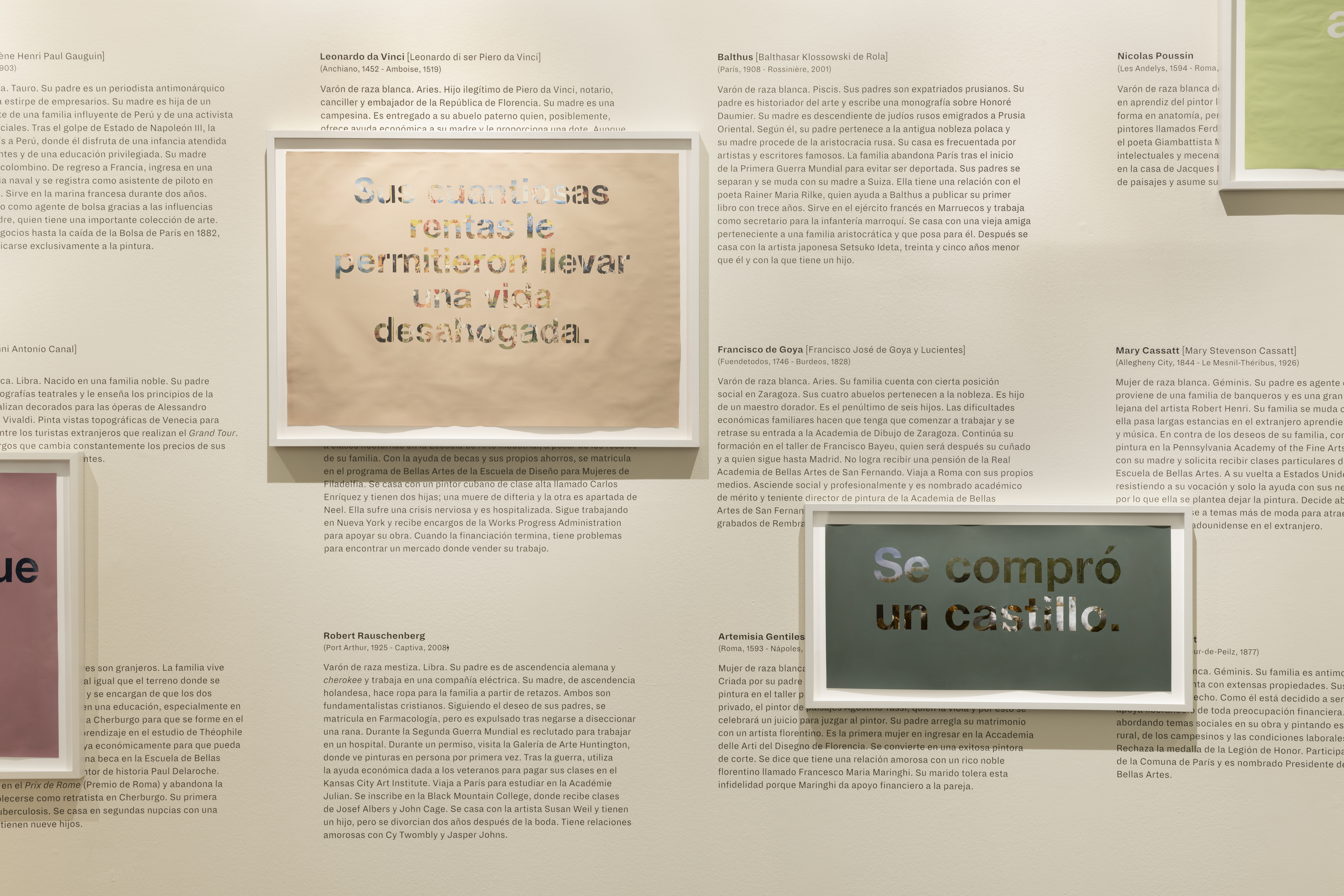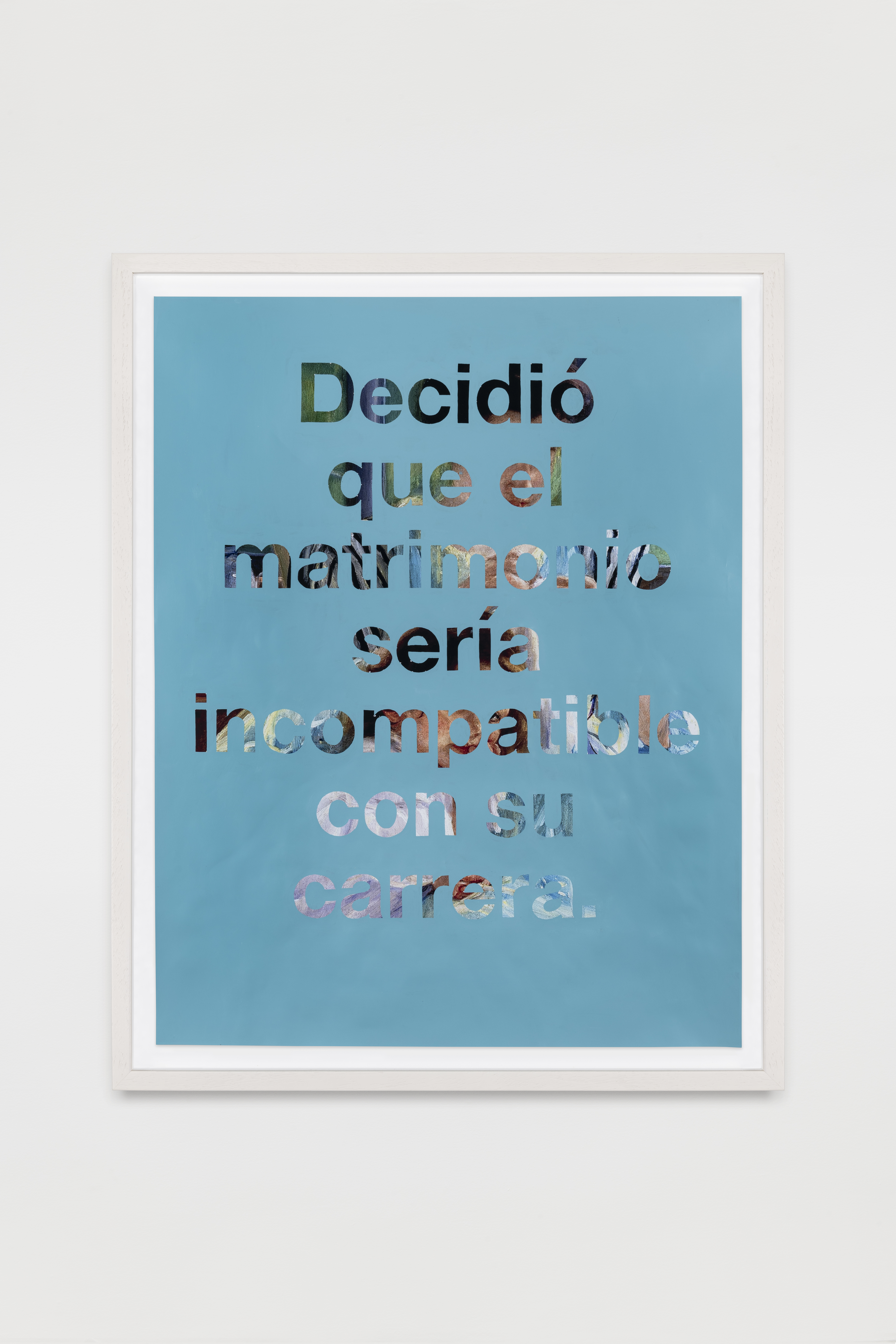Masters of Western Painting
2023
Text mural.
Dimensions variable.
Acrylic paint on posters.
Dimensions variable.
Leer en español →
In The Best Job in the World,
I interviewed artists who abandoned their artistic practice,
prompting a reflection on the factors that drive and sustain artistic
vocations. Using biography as a tool, I explored how social, economic,
and cultural capital might shape Western artistic “genius.” In Masters of Western Painting (2023), a text mural analyzes the early lives of 100 painters, while
intervened posters present famous masterpieces partially obscured by
biographical quotes painted in negative, inviting viewers to reconsider
these works from a social, psychological, or cultural perspective.













More Info
In The Best Job in the World (2021) I performed a series of interviews to Spanish artists who had abandoned art. These conversations led me to wonder why I am l active as an artist, and also, which conditions and events occurred in the lives of the artists in Art History that could have awakened their vocation and which could help to develop it along with their talent?
In this text mural and series of interventions in posters acquired in museum shops or fabricated for the occasion, I aimed to trace these questions by using the artist’s biography as a tool to trace Western artistic “genius” in a critical way, relating them to the three forms of capital designated by the sociologist Pierre Bourdieu – social, economic and cultural – as the main resources that an individual has when is born.
Presented together in a large-scale wall installation in my solo exhibition The Origin of Forms at Museo Centro de Arte Dos de Mayo (Móstoles, 2023-2024) the text mural is a carefully edited text resultant from my inquiry in the early biographies of one hundred Western dead painters – from Giotto to Paula Rego –, in official biographical sources –such as Encyclopedia Britannica –, paying special attention to the social and psychological environment in which these artists grew up.
The intervened posters present images of very famous paintings by the forementioned artists, partially hidden under a found phrase from their biography, outlined with acrylic paint. This exercise aims to provoke a round trip for us to read their work through a certain biographical prism, whether social, psychological or cultural.
In The Best Job in the World (2021) I performed a series of interviews to Spanish artists who had abandoned art. These conversations led me to wonder why I am l active as an artist, and also, which conditions and events occurred in the lives of the artists in Art History that could have awakened their vocation and which could help to develop it along with their talent?
In this text mural and series of interventions in posters acquired in museum shops or fabricated for the occasion, I aimed to trace these questions by using the artist’s biography as a tool to trace Western artistic “genius” in a critical way, relating them to the three forms of capital designated by the sociologist Pierre Bourdieu – social, economic and cultural – as the main resources that an individual has when is born.
Presented together in a large-scale wall installation in my solo exhibition The Origin of Forms at Museo Centro de Arte Dos de Mayo (Móstoles, 2023-2024) the text mural is a carefully edited text resultant from my inquiry in the early biographies of one hundred Western dead painters – from Giotto to Paula Rego –, in official biographical sources –such as Encyclopedia Britannica –, paying special attention to the social and psychological environment in which these artists grew up.
The intervened posters present images of very famous paintings by the forementioned artists, partially hidden under a found phrase from their biography, outlined with acrylic paint. This exercise aims to provoke a round trip for us to read their work through a certain biographical prism, whether social, psychological or cultural.
Credits
General installation views and details of the exhibition The Origin of Forms [El origen de las formas], Museo Centro de Arte Dos de Mayo (Móstoles, 2023).
Masters of Western Painting (2023) Text mural. Dimensions adjusted to fit. Design: Álex Gifreu.
Masters of Western Painting – Mark Rothko, No. 5/ No. 22 (2023) 89 x 73,5 cm. [Text: ‘He felt bitterness over his lost childhood.’]
Masters of Western Painting – Johannes Vermeer, Het straatje (2023) 70 x 50 cm. [Text: ‘He couldn't feed his large family.’]
Masters of Western Painting – Claude Gellée, Port de mer au soleil couchant (2023) 50 x 70 cm. [Text: ‘He was not the ignorant peasant of the legend.’]
Masters of Western Painting – Giotto, Fuga in Egitto (2023) 70 x 70 cm. [Text: ‘He got along well with both the nobles and the common people.’]
Masters of Western Painting – Edward Hopper, Hotel Room (2023) 57 x 61,3 cm. [Text: ‘He sold his first painting at the age of thirty-one.’]
Masters of Western Painting – Eugène Delacroix, La Liberté guidant le peuple (2023) 50 x 70 cm. [Text: ‘The state continuously sponsored his nonconformist art.’]
Masters of Western Painting – Jackson Pollock, Lucifer (2023) 50,5 x 101,5 cm. [Text: ‘The smell of turpentine came to disgust her.’]
Masters of Western Painting – Mary Cassatt, Mother and Child (2023) 90 x 70 cm. [Text: ‘She decided that marriage was incompatible with her career.’]
Masters of Western Painting – Elisabeth Louise Vigée-Lebrun, Madame Vigée Le Brun et sa fille (2023) 70 x 50 cm. [Text: ‘At fifteen, he already had his own studio.’]
Masters of Western Painting – Henri Matisse, La Danse (2023) 70 x 92 cm. [Text: ‘While recovering from appendicitis, his mother brought him painting supplies to the hospital.’]
Masters of Western Painting – Helen Frankenthaler, Provincetown Window (2023) 94,5 x 84 cm. [Text: ‘Poor artists envied her.’]
Images: Roberto Ruiz.
General installation views and details of the exhibition The Origin of Forms [El origen de las formas], Museo Centro de Arte Dos de Mayo (Móstoles, 2023).
Masters of Western Painting (2023) Text mural. Dimensions adjusted to fit. Design: Álex Gifreu.
Masters of Western Painting – Mark Rothko, No. 5/ No. 22 (2023) 89 x 73,5 cm. [Text: ‘He felt bitterness over his lost childhood.’]
Masters of Western Painting – Johannes Vermeer, Het straatje (2023) 70 x 50 cm. [Text: ‘He couldn't feed his large family.’]
Masters of Western Painting – Claude Gellée, Port de mer au soleil couchant (2023) 50 x 70 cm. [Text: ‘He was not the ignorant peasant of the legend.’]
Masters of Western Painting – Giotto, Fuga in Egitto (2023) 70 x 70 cm. [Text: ‘He got along well with both the nobles and the common people.’]
Masters of Western Painting – Edward Hopper, Hotel Room (2023) 57 x 61,3 cm. [Text: ‘He sold his first painting at the age of thirty-one.’]
Masters of Western Painting – Eugène Delacroix, La Liberté guidant le peuple (2023) 50 x 70 cm. [Text: ‘The state continuously sponsored his nonconformist art.’]
Masters of Western Painting – Jackson Pollock, Lucifer (2023) 50,5 x 101,5 cm. [Text: ‘The smell of turpentine came to disgust her.’]
Masters of Western Painting – Mary Cassatt, Mother and Child (2023) 90 x 70 cm. [Text: ‘She decided that marriage was incompatible with her career.’]
Masters of Western Painting – Elisabeth Louise Vigée-Lebrun, Madame Vigée Le Brun et sa fille (2023) 70 x 50 cm. [Text: ‘At fifteen, he already had his own studio.’]
Masters of Western Painting – Henri Matisse, La Danse (2023) 70 x 92 cm. [Text: ‘While recovering from appendicitis, his mother brought him painting supplies to the hospital.’]
Masters of Western Painting – Helen Frankenthaler, Provincetown Window (2023) 94,5 x 84 cm. [Text: ‘Poor artists envied her.’]
Images: Roberto Ruiz.